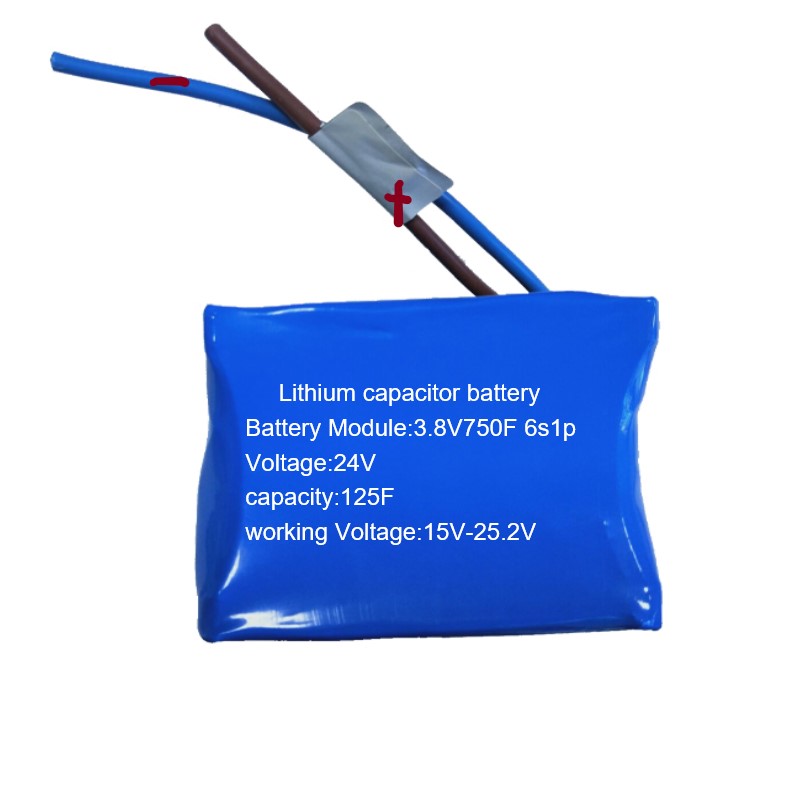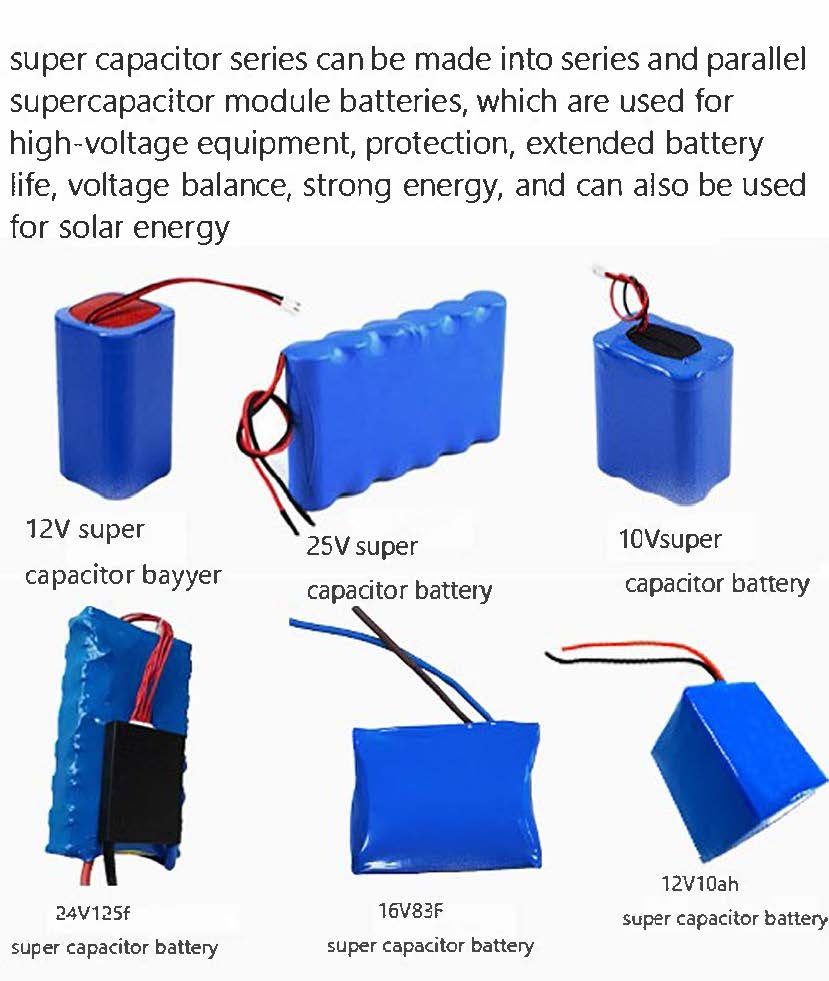Consulting phone:
135-3037-2041
(Mr.Wang)
Product introduction:
The hybrid capacitor module is composed of 21700-2500MAH * 8 in parallel to form 24V60WH. Two hybrid supercapacitors are designed to realize instant charging and discharging. Compared with NiMH batteries, the energy storage performance is greatly improved. The hybrid supercapacitor has a capacitive titanium carbide based negative electrode and a battery type graphene mixed positive electrode.
The energy density of this new energy storage device is close to that of nickel metal hydride battery, but it can also provide ultrahigh power of super capacitor level, about 10 times that of lithium battery.
The power density works in both directions, which means that the battery pack does not hinder the power output. Under the condition that today's Pl+Te has an amazing horsepower of more than 1100 horsepower, the equivalent product based on the hybrid super capacitor will have a battery pack that can provide five times the power for the motor.
Product specification:
project | characteristic |
| Rated voltage | 18V-28V or customized |
| Capacity | 125F or customized |
| Operating temperature | - 40 ℃ - 65 ℃ |
| Tolerance | |
| power | 1500W |
| size | 80*100*60mm |
| Charging voltage/current | 24V/5A |
Temperature characteristic | from - 40 ℃ to 65 ℃ Capacity change: 30% of △ c ∠ initial measured value @ 25 ℃ Internal resistance change: 100% of △ ESR ∠ nominal value |
| High temperature load life | 25 ℃ and rated voltage, load 1500h capacity change: 30% of the initial measured value of △ c ∠ @ 25 ℃ internal resistance change: 100% of the nominal value of △ ESR ∠ |
| Normal temperature load life | 10 year capacity change of load under normal temperature load life of 25 ℃ and rated voltage: 30% of △ c ∠ initial measured value @ 25 ℃ internal resistance change: 100% of △ ESR ∠ nominal value |
| Normal temperature cycle life | of 25 ℃, the capacity change after 500000 charge discharge cycles (from rated voltage to 1/2 rated voltage): 30% of the initial measured value of △ c ∠ @ 25 ℃ internal resistance change: 100% of the nominal value of △ ESR ∠ |

Scope of application:
1. Telecommunications: mobile phones, walkie talkies, cordless phones
2. Portable devices: digital camera, portable DVD, portable TV
3. Portable equipment: GPS, PDA, PMP, PSP, portable medical equipment, instruments, etc
4. Lighting equipment: miner's lamp, searchlight, lighting device and emergency light.
5. Others: toys, remote control models, electric tools, widely used in POS systems, solar power supply systems, electric tools, household appliances and emergency equipment. Electric bicycle and notebook
Computers, cameras, military equipment: infrared telescopes, medical equipment.
Test method:
1. Electrostatic capacity tester
(1) Test principle
The electrostatic capacity of supercapacitor is measured by the method of constant current discharge of the capacitor and calculated according to the formula. C=It (U1-U2), where: C - electrostatic capacity, F; I - Constant discharge current, A; U1, U2 - voltage, V; Discharge time required from t-U1 to U2, S
(2) Test procedure
Charge the capacitor with a current of 100A until the capacitor is charged to the working voltage and the voltage is constant for 10 seconds, then discharge the capacitor with a current of 100A, taking U1 as 1.2VU2 as 1.0V, record the discharge time within the voltage range, the total circulating electrostatic capacity, and take the average
2. Storage energy
(1) Testing
The energy test of super capacitor is carried out by discharging the capacitor to 1/2 of the working voltage at constant power within the voltage range given by the capacitor. The output energy W of capacitor is obtained from the relationship between constant discharge power P and discharge time T, that is, W=P. T
(2) Test procedure
Charge the capacitor to the working voltage with a constant current of 100A, and then keep it constant until the charging current drops to the specified current (traction type 10A, starting type 1A). After 5 seconds of standstill, discharge the capacitor to 1/2 of the working voltage with a constant power, record the discharge time and calculate the value. Cycle 3 measurements and take the average value
3. Equivalent series resistance test (DC)
(1) Test principle
The internal resistance of the capacitor is measured according to the sudden change of voltage within 10ms after the capacitor disconnects the constant current charging circuit. In the formula: R-internal resistance of capacitor; U0 - Voltage before capacitor cut-off charging; Ui - Voltage within 10 ms after switching off charging; I - Cut off the current before charging.
(2) Measuring process
Charge the capacitor with a constant current of 100A, disconnect the charging circuit when 80% of the charging working voltage is reached, use a sampling machine to record the voltage change within 10 ms after the capacitor is powered off, calculate the internal resistance, repeat for 3 times, and take the average value.
4. Leakage current test
After the capacitor is charged to the rated voltage with a constant current of 100A, the capacitor is charged at this voltage for 30min at a constant voltage, and then it is left open for 72h. In the first three hours, record the voltage value every minute, and in the remaining time, record the voltage value every ten minutes.
Calculate the self discharge energy loss, SDLF=1 - (V/VW) 2, and the calculation time points are respectively 0.5,1,8,24,36,72h
Note: The voltage tester must have high input impedance to minimize the sound of the film.
Precautions:
Super capacitors cannot be used in the following states:
1) Temperature above nominal temperature
When the capacitor temperature exceeds the nominal temperature, the electrolyte will decompose, and the capacitor will generate heat and the capacity will decrease,
Moreover, the internal resistance is increased and the service life is shortened.
2) Voltage exceeding rated voltage
When the capacitor voltage exceeds the nominal voltage, the electrolyte will decompose, and the capacitor will heat up and the capacity will drop,
Moreover, the internal resistance is increased and the service life is shortened. Therefore, reducing the service voltage can improve the service life.
3) Loading of reverse voltage or AC voltage
1. Influence of ambient temperature on supercapacitor
The service life of supercapacitor is affected by the service temperature. Generally, if the service temperature is increased by 10 ℃, the service life of supercapacitor will be shortened by half. Please try to use it in a low temperature environment lower than the service temperature. If it is used beyond the service temperature, it may cause sharp deterioration and damage of the characteristics.
The use temperature of the super capacitor should not only confirm the ambient temperature and internal temperature of the equipment, but also confirm the radiation heat of the heater (power transistor, resistor, etc.) in the equipment, and the self heating temperature caused by ripple current. In addition, do not install the heater near the supercapacitor.
2. Please use the capacitor correctly according to the positive and negative pole marks.
3. Please avoid using super capacitors in the following environments.
a) The environment is directly splashed with water, salt water and oil, or is in the state of condensation and full of gas like oil or salt.
b) An environment full of harmful gases (hydrogen sulfide, sulfurous acid, chlorine, ammonia, bromine, methyl bromide, etc.).
c) Environment splashed with acidic and alkaline solvents.
d) Direct sunlight or dusty environment.
e) An environment subject to excessive vibration and shock.
4. Avoid overheating the capacitor during welding (for 1.6mm printed circuit board, the welding temperature shall be 260 ℃, and the time shall not exceed 5s).
5. Please avoid conducting circuit wiring between the outgoing poles of the super capacitor or between the solder joints of the connecting plate.
6. Overvoltage, exceeding the operating temperature range and other conditions beyond the rated conditions may cause the pressure valve to act and the electrolyte will be ejected. Therefore, please adopt the design method that has considered the possible occurrence of this abnormal condition.
7. During fast charging and discharging, voltage drop (also called IR drop) caused by internal impedance will be generated at the beginning of charging and discharging. Therefore, please adopt the design method that has considered the voltage change range.
8. If the terminals of power type high-capacity products (products above 10F) are short circuited during charging, hundreds of amperes of current will flow through, which is dangerous. Do not install or remove the battery in the charged state.
9. Do not put the capacitor into the dissolved solder, only stick solder on the guide pin of the capacitor. Do not let the welding rod contact the capacitor heat shrink tube.
10. Do not twist or tilt the capacitor forcibly after installation.
11. When the supercapacitor is used in series, there is a problem of voltage balance between individual capacitors
matters needing attention:
1、 Use
1. The operating temperature of lithium ion capacitor should not exceed the upper or lower limit of rated temperature (- 20 ℃~+55 ℃)
2. Lithium ion capacitors shall be used at nominal voltage. In order to prolong the service life of the product, we recommend that the monomer be used within the range of "rated voltage" (2.5v-3.8v).
3. Before using the lithium ion capacitor, please acknowledge the polarity and prevent reverse connection.
4. The external ambient temperature has a weight impact on the life of the lithium ion capacitor. Please keep away from heat sources.
5. Do not touch water, oil, acid or alkali directly.
6. Do not knead, nail or disassemble the lithium ion capacitor.
7. Do not discard the lithium ion capacitor at will, and dispose it according to the national environmental protection standards.
2、 Storage
1. During transportation, the lithium ion capacitor shall be handled with care to avoid violent vibration, kneading, rain and chemical corrosion.
2. The lithium ion capacitor shall not be located in a place with a relative humidity of more than 85% or containing toxic gas. In such an environment, the lead and shell are prone to moisture and corrosion, which may cause the circuit break of the ultrafast charging battery.
3. If the lithium ion capacitor needs to be stored for a long time, please store it in a place with excellent ventilation and temperature of - 40~35 ℃ and relative humidity below 50%.